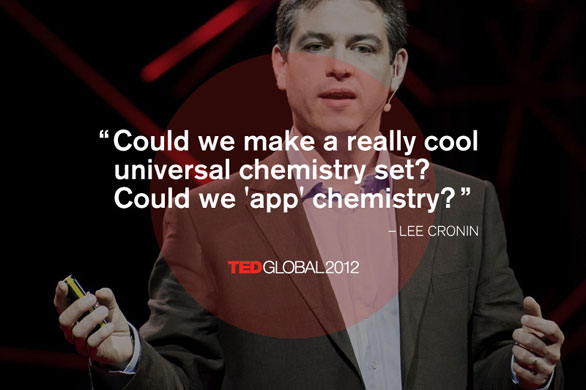 From ordering movie tickets to booking a dentist appointment, mobile and web apps have made the tasks of daily life easier. But there are some things that an app can’t do. Standing in line at the pharmacy is one of them.
From ordering movie tickets to booking a dentist appointment, mobile and web apps have made the tasks of daily life easier. But there are some things that an app can’t do. Standing in line at the pharmacy is one of them.
 Lee Cronin: Print your own medicine
In today’s talk, Lee Cronin asks: “Could we make a really cool universal chemistry set? In essence, could we app chemistry?”
Lee Cronin: Print your own medicine
In today’s talk, Lee Cronin asks: “Could we make a really cool universal chemistry set? In essence, could we app chemistry?”
With his team of researchers at the University of Glasgow, Cronin has created a 3D printing application that allows scientists to print out laboratory equipment specific to the experiment they wish to run — something they’ve called “reactionware.” Someday, Cronin says, the same software that runs reactionware could open up the doors of possibility. In this talk, Cronin shares one application — the idea that, in the future, people could print their medicine. With a custom-built 3D printer and chemical inks, users would download the appropriate molecules to perform “on-the-fly molecular assembly.” Meaning that they could print out whatever medications were needed that day — even if they were for a new superbug.
At TED, we love sharing stories of 3D printing and its rapidly developing power to make new things possible. TED Fellow Bre Pettis’s Makerbot; the Thingiverse database allow makers worldwide to share designs for printers; designers printing artificial limbs; artists re-inventing their process — we can’t wait to see what’s next. In honor of 3D printers here are some TED and TEDx talks on understanding this technology.
[ted id=1335]
Lisa Harouni: A primer on 3D printing
So what exactly is 3D printing? Lisa Harouni breaks it down — from machine to design to product. Learn how it all works in this talk from TEDSalon London Spring 2011.
Klaus Stadlmann: The world’s smallest 3D printer
Klaus Stadlmann built the microprinter, the smallest 3D printer in the world. In this talk from TEDxVienna, he demos this tiny machine that could someday make customized hearing aids — or sculptures smaller than a human hair.
Scott Summit: Beautiful artificial limbs
In his work, prosthetics designer Scott Summit noticed that a lot of people had to hack their own artificial limbs — with socks, bubble wrap, even duct tape — to feel comfortable. In this talk from TEDxCambridge, he describes how he turned to 3D printing to create limbs that not only match a person’s body, but their personality as well.
[ted id=1088]
Anthony Atala: Printing a human kidney
The shortage of organ donations is a crisis in healthcare. A possible solution? Printable organs. In this stirring talk from TED2011, Anthony Atala describes his research into the development of an organ-printing 3D printer, and introduces a recipient of the product of a similar technology — a bladder grown by borrowed cells.
[ted id=1496]
Marc Goodman: A vision of crimes in the future
Sometimes, despite the very best intentions, the things we create aren’t used in the ways we thought they would be. In this talk from TEDGlobal 2012, Marc Goodman draws from his experience in law enforcement to show the dark side of technology — what happens when great tools get into the wrong hands. In his talk, he shows a way 3D printing could be used for harm and cautions us to guard against these potentials.
David F. Flanders: Why I have a 3D printer
David F. Flanders is a 3D printing guru and the host of PIF3D, a collective dedicated to hosting “build parties,” during which 3D printing experts help curious outsiders build personal 3D printers. In this talk from TEDxHamburg, he discusses the development of the technology and the implications of its mass use, including 3D printers’ role in recovery relief, architecture, and the office supply closet.
Comments (35)
Pingback: 5 Body Parts Scientists Can 3-D Print | cecbyceos
Pingback: 10 old movies about new technology | BizBox B2B Social Site
Pingback: 10 old movies about new technology | H Tanalepy
Pingback: TED talks, 7 talks on the wonder of 3D printing
Pingback: Hey Everyone! Lasers and PROMPT | aJonester
Pingback: Reflection Week 7: **** | Math Fun with Miss Barben
Pingback: How 3D printing will change everything – including education by Tryggvi Thayer | Behind the Teacher's Desk
Pingback: Lasso the Moon Going Beyond Knowledge » Lasso the Moon
Pingback: The Radical Democratization of Capability: Lessons From the World of 3D Printing – by Mobius Consultant, and Transformational Faculty, Cat Tweedie | Mobius Leadership Blog
Pingback: وداعا صنع في الصين” الطباعة باستخدام تقنية الثلاثة ابعاد | ADEN - Jewel Of Arabia
Pingback: Revue des sciences mars 2013 | Jean Zin
Pingback: In short: A powerful spoken word reflection on bullying, the history of Bill Cosby’s sweaters | H Tanalepy
Pingback: In short: A powerful spoken word reflection on bullying, the history of Bill Cosby’s sweaters | Krantenkoppen Tech
Pingback: Video: The Best 7 TED Talks On 3D Printing
Pingback: How 3D printing will change everything – including education | Education4site
Pingback: In short: The true story of Kid President, the danger of Dr. Oz | Krantenkoppen Tech
Pingback: Print your own medicine « Talesfromthelou's Blog
Pingback: Wizmo Blog » Blog Archive » 7 talks on the wonder of 3D printing